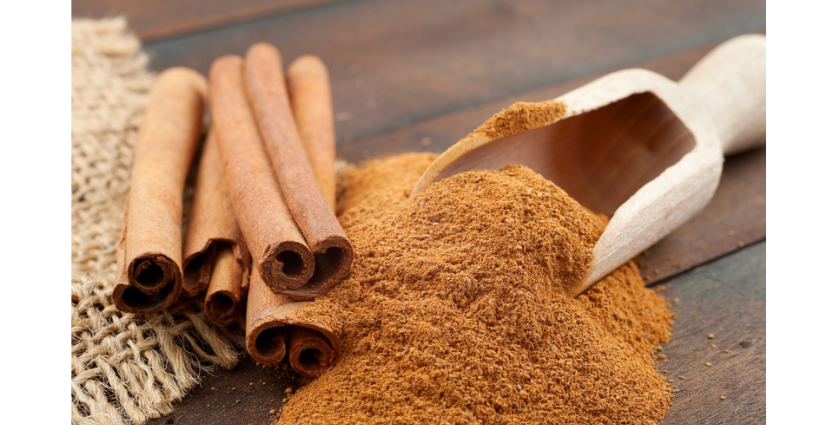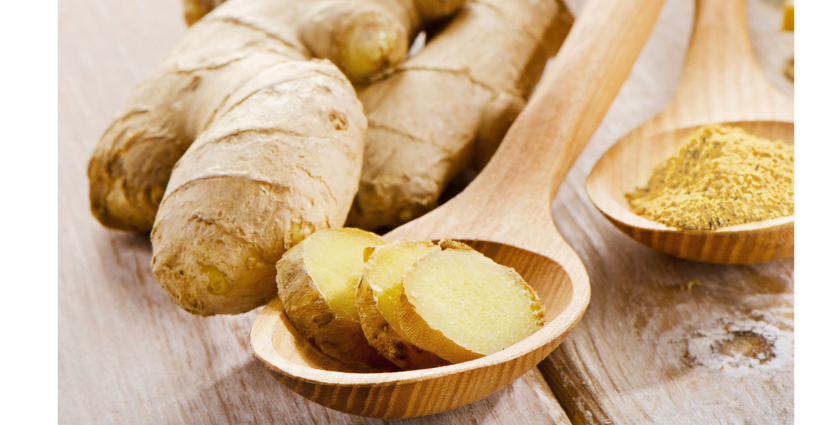Savor the season: Ginger, nutmeg, cloves & cinnamon

Savor the season: Ginger, nutmeg, cloves & cinnamon
As a nutritionist, I couldn’t be more thankful to….my spice rack. No matter which one I select, a sprinkle adds delicious flavor and warm coziness to my creations, not to mention, an out-of-this-world aroma to my whole house. Whether I’m whipping up a scrumptious side for a small gathering or delicious dessert recipe for a large holiday party, the inclusion of seasonal spices—fragrant cinnamon, warming nutmeg, woody cloves and earthy ginger—takes any dish over the top. Read on to learn more about the flavors, health perks and tasty ways to incorporate these spices into your holiday cooking.

Savor the season: Cinnamon
Cinnamon
Cinnamon for the win! The ancient spice comes from the bark of different types of cinnamon trees grown in various countries, most commonly in Sri Lanka (this type, called Cinnamomum verum, is referred to as true cinnamon) or Asia (this is called Cinnamomum cassia, and is what’s sold in US and Canada). The two main varieties of cinnamon are ceylon and cassia; they have different appearances and flavors—ceylon is tan with a mild, sweet flavor; cassia is red-brown with a stronger, more pungent taste and smell.
Cinnamon has been used medicinally for centuries because it has antibacterial, antimicrobial, antioxidant, anti-inflammatory, and antidiabetic properties. It contains vital oils and biologically active compounds, including the polyphenol cinnamaldehyde. It may help reduce blood sugar, according to preliminary studies, although it does not seem to control A1C levels, a measure of blood sugar over time. More research is needed to confirm, but if you enjoy the spice, it’s certainly a wonderful addition to recipes.

Savor the season: Cinnamon recipes
Cinnamon is one of the most used and most beloved spices out there. I don’t know if I love the warm, subtly sweet, spicy flavor or its fragrant smell better. It adds a cozy goodness to oats or oatmeal bakes, it pairs perfectly with a pinch of sugar as a tasty topping on a variety of treats and it’s a star ingredient in a popular recipe—my Cinnamon Buns. Check out the recipes below for some cinnam-inspiration!
Remember to store it in an airtight container in a cool, dark place so it stays fresh. It can last for two years, though you may notice the flavor lessens over time. Feel free to use cinnamon sticks during the cooking process—don’t forget to remove before serving; sprinkle or stir ground cinnamon into dishes for enhanced flavor; or the powder, a finer version of ground cinnamon. All are delish and offer benefits.
Cinnamon Buns (AKA my Cinna-Yums)
Cinnamon Roll Oatmeal Bake
Cinnamon Sugar Donut Holes
Cinnamon Sugar Pumpkin Seeds
Cinnamon Raisin Protein Bagel
Maple Cinnamon PB Dip

Savor the season: Nutmeg
Nutmeg
It’s easy to see why chefs go nuts for nutmeg…it adds warmth to desserts like apple pie, flavor to classic beverages such as eggnog, and depth to creamy sauces including alfredo and bechamel.
Nutmeg comes from the seed of a peach-like fruit that grows on the nutmeg tree, a type of evergreen tree in Indonesia. The seed is dried in the sun over the course of several weeks then separated from the outer coat (called mace, which is also sold as a spice).
Nutmeg, which has been shown to have antimicrobial and antioxidant powers, has been used to treat digestive issues as well as help relieve pain, including diabetic neuropathy. Studies confirming these benefits have been small and limited, but there’s no debating its ability to elevate recipes.

Savor the season: Nutmeg recipes
Nutmeg lends a nutty, gently sweet flavor and has a strong and distinct aroma. If you are sensitive to heat, you may even find it a little spicy to the taste. You can buy nutmeg as the whole seed or already ground. There are pros and cons to both—the whole seed offers more flavor when grated into recipes and it lasts a long time (almost indefinitely). Ground nutmeg, which is sold in very small containers, is convenient, but often not as flavorful and typically stays fresh only about six months.
Try sprinkling nutmeg into one or more of these tasty recipes:
Noodle-free Sweet Potato Mac & Cheese
Pumpkin Spice Latte
Pumpkin Cheesecakes
Savory Pumpkin Meatballs
Slow Cooker Chocolate Banana Bread
Butternut Squash Soup

Savor the season: Cloves
Cloves
These gems got their name from their shape—“clove” comes from the Latin word for “nail.” They are handpicked from the flowers of an evergreen tree found in Indonesia. They provide an intense flavor and can even cause a numbing sensation in the mouth due to the spice’s aromatic compound, eugenol.
Cloves are rich in antioxidants. In fact, among spices, it’s one of the highest in polyphenols and antioxidants. Because of its numbing powers—eugenol is like a natural anesthetic—it’s added to mouthwashes and other healthcare products. Cloves also have some anti-inflammatory properties and may help with issues like tooth pain and possibly even managing blood sugar.

Savor the season: Clove recipes
Cloves are a key ingredient in one of my favorite sauces…if you’ve seen any of my TODAY show spots, you know I struggle to pronounce “Worcestershire sauce,” lol, and simply refer to it as “W sauce.” It’s also used in masala chai tea, mulled wine and hot apple cider, and you may have seen them sticking out of holiday hams, too. They’re often used during the cooking process and removed just before serving.
This is one case where a little goes a long way—its flavor is just slightly sweet, bitter, and almost hot. You can find them whole and ground, but most chefs prefer to use whole cloves when cooking because they lend more flavor and last longer (up to a year when stored in a cool, dark place).
A cool hack from McCormick: Spike an onion with multiple cloves, use during the cooking process to enhance the flavor of your dish, then remove the whole onion before serving. Delish! Check out some other tasty ways to show some cloves some love:
Eggnog Cheesecake Dip
Spiced Chai
Spiced and Sparkling Chilled Chai

Savor the season: Ginger
Ginger
More than just a slang nickname for beloved British singer-songwriter Ed Sheeran, ginger is also a power spice shown to have significant health perks. It contains gingerol, which has anti-inflammatory properties. In fact, it may help relieve aches and pains as well as some over-the-counter pain meds as well as help ease mild nausea.
Ginger is a rhizome, the underground stem of the flowering ginger plant. It’s grown in Asia and is sold both fresh—you can find the tan root, similar in appearance to fat, knobby fingers, in the produce section at the grocery store sold as chunks—or as a powder in the spice aisle. Powdered ginger is often used in baking and packs a more powerful punch than fresh. Both offer health perks. You can store fresh ginger in the fridge; powdered ginger in a cool, dry, dark place.

Savor the season: Ginger recipes
Ginger is a great way to enhance flavor in a variety of recipes, whether you steep fresh slicesin hot water to make a comforting tea, add a sprinkle to dessert recipes for an extra kick or use it to add a warm, fiery flavor to entrées.
Here are some of my favorite dishes that incorporate ginger:
Honey-Ginger Salmon
Carrot-Ginger Dressing
Ginger Turmeric Cherry Tea
Passionfruit Mimosa Mocktail
Lime Ginger Baby Cakes

